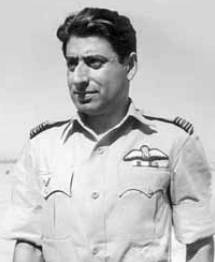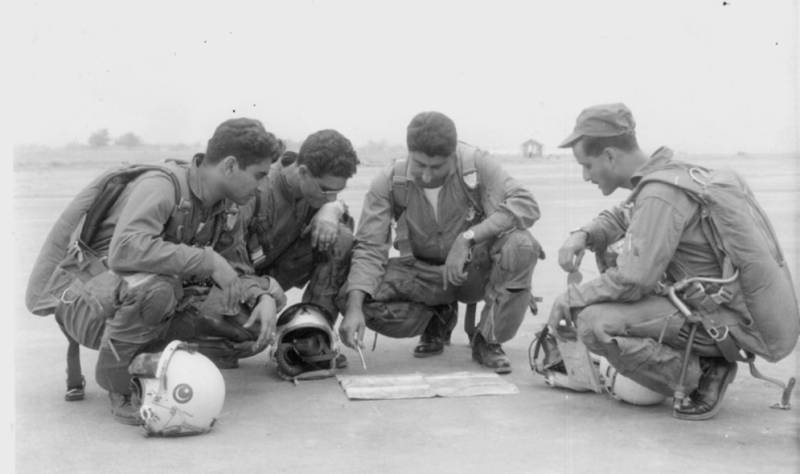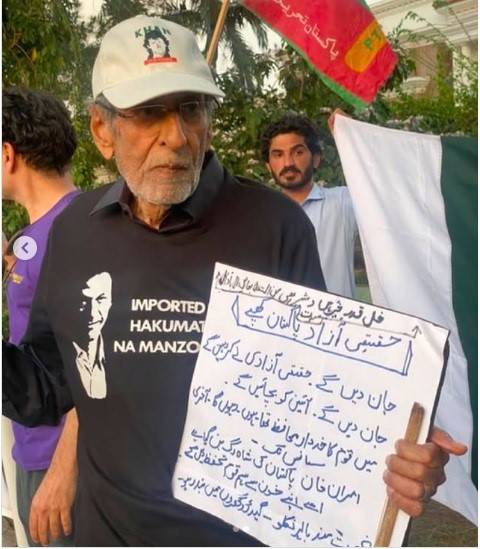
Air Commodore Sajad Haider breathed his last on 3 January 2025. He lived a long innings and departed for the eternal world at the ripe age of 91 years. He lived life to the full and charted his own course in every phase of his life. He remained physically and mentally active till the very end of his journey on this earth.
Sajad Haider was born in Sargodha in 1932. His father, a doctor, moved to Quetta, where Sajad went to St Francis’ Grammar School. He followed up his education at FC College Lahore before joining PAF Academy in 1951 for flying training as a fighter pilot. He showed promise as an aggressive air warrior and, early in his career, was part of the team of 16 F-86s who performed a formation loop in 1958 in Karachi in honour of the visiting Afghan King. He was the last of the living heroes and medal winners of the 1965 war.
Sajad remained a maverick throughout his life. The word means unorthodox and independent minded person; an expression that defined his character. He never sailed with the wind nor fell into sycophancy. He belonged to the category of the WWII air warriors, especially those who flew during Battle of Britain and had a romantic aura. They were the mavericks who wouldn't think of going up in the air in the morning if they hadn't had half a bottle of whiskey under their belt the previous night and made love to some star smitten damsel; and that’s what Sajad was. Always impeccably dressed, he appeared flamboyant and charismatic in every gathering he attended. As a superb fighter pilot and a formidable leader, he brimmed with confidence; at times with overconfidence bordering insubordination. His arrogance invited envy, wrath and hostility of many of his colleagues and seniors. His tribulations due to his brazenness were not unique. Armed forces demand complete obedience; even the likes of George Patton and Douglass McArthur, much more renowned WW2 US heroes, were penalised for actions and pronouncements that were considered to be beyond their sphere of responsibility as field commanders.
Sajad Haider earned his fame during the opening phases of the September 1965 Indo-Pak war. The Pakistan Air Force (PAF) shall always look back with pride for the sacrifices as well as offensive actions on the days of the 6th and 7th pf September 1965. The precisely executed ground attacks by No 19 Sqn under the command of Sajad Haider on the morning and evening of the 6th, and the heroics in the air battle on the 7th by MM Alam shall illuminate the path for future generations of PAF.

While PAF tragically lost Sqn Ldr Sarfraz Rafiqui and Flt Lt Yonus over Halwara on the evening of 6 September 1965, it was also the day that propelled Sajad Haider as a true wartime hero. The history of 1965 Indo-Pak war, as recorded by the Pakistani as well as the Indian historians, agrees that a formation of six Sabres led by Sajad Haider blunted the Indian ground attack on Lahore in the morning of the 6th.
Maj Gen Lachman Singh in his book Missed Opportunities states that during their 15 minutes or so over the target area, Pakistani F-86s shot up every vehicle on the road; and that included tanks, RCL gun-mounted jeeps, mortars with carriers and troop transports. A Pakistan Army observer estimated that at least 10 armoured vehicles had been destroyed by the end of the attack. Only seven tanks were claimed by the PAF, plus another 20 vehicles which were machine gunned after all the rockets had been expended. It was later learned that this Indian army brigade was forming up to launch an attack across the BRB canal towards Lahore. The PAF attack achieved a vital delay which enabled Pakistan Army forces to move into position to block any further Indian advance. The surprise attack by Indian forces to take Lahore – and famously, to have a drink in the Lahore Gymkhana – was blunted by the brave and methodical fighter pilots of the 19th Squadron under the leadership of Sajad.
Consequently, after the war, the commanding officer and his number two of Indian 3-Jat regiment were court-martialled and removed from service. This aerial attack was so effective that, according to Sajad himself (ibid) he found at the close of the war that the Indians were exactly at the place where he had attacked them on the opening day of the war. He deservedly earned the honorific of “Saviour of Lahore.” However, the day would bring him more laurels and earn the PAF more glory.
The devastating raid on Indian Air Base Pathankot will remain the defining moment for PAF. Sajad led a formation of 8 Sabres on ground attack mission with an additional 2 as escort. Achieving a complete surprise, PAF extracted a heavy damage. According to Jagan Mohan and Samir Chopra, the authors of India Pakistan Air War of 1965, "The raid had been highly successful, resulting in the destruction of 10 IAF aircrafts; 6 Mystères from 3 Squadron, 2 from 31 Squadron, 1 Gnat, 1 Fairchild Packet and 2 MiG-21s. Three other aircrafts were damaged."
In a BBC interview conducted perhaps midway during the war, Sajad appears absolutely confident, brash and ebullient. He was awarded the coveted Sitara-e-Jurat for his exceptional bravery and skill.
His conduct puts to shame all those civil and military bureaucrats who become quislings or henchmen of various dictators, and whose desire to enter the corridors of power overrides their sense of propriety
During the 1971 war, he was commanding the flying wing at Sargodha, the most prestigious position in the PAF at operational level. His wing carried out extensive missions including the devastating strike at Mukerian Railway Station led by Wg Cdr Hakimullah (later Air Chief), which was the only interdiction mission undertaken by Mirage aircraft deep inside enemy territory. In his book, Sajad has been critical of Sargodha commanders for poor utilisation of air effort during the 1965 war. However, he didn’t address the question of underutilisation of Mirages, directly under his command as OC Flying Wing, for interdiction of Indian logistics and troop concentrations in the early days of 1971 war, which would have had severe adverse effects on their strike capability from Shakargarh in the north to Ferozepur in the south. Such tasking is the responsibility of the joint command, but he could have enlightened his readers on the reasons and effects of this shortcoming.
Sajad’s analysis of air operations during the 1965 and 1971 wars, as provided in his book Flight of the Falcon, are very incisive and objective. His narrative shows the valour of our fighting troops and the infirmity of the leadership. He has relied on information gained by his own participation as a squadron and wing commander (equivalent to a battalion and a brigade commander in army), personal knowledge derived during his post-1965 service, close interactions with other important figures in the army and air force, some personal hindsight and extensive reading of Indian writers. This author is not qualified to comment on his analysis of air operations or his evident dislike for some of his senior PAF officers, except that it is written with a longing heart, absolute clarity and good diction. Apparently, his teachers in Quetta and Lahore did an admirable job. A few years ago, he also launched his personal website to show case his memorabilia, and a YouTube channel.
He wouldn't remain quiet about unprofessionalism, corruption or misuse of authority within the air force or beyond in the national institutions. He had a sharp mind and expressed his views without reservations or regard to protocol. His demeanour antagonised many. He successively fell out with his OC Flying Wings, Base Commanders, Air Officers and every other senior who fell short in his eyes. In 1973, one of those commanders had risen to be the Air Chief and, as claimed by Sajad in his book, had him falsely implicated in the infamous Attock Conspiracy case against the government of Bhutto. That saw many bright professional officers punished for attempted mutiny by court martials headed by then Maj Gen Zia-ul-Haq in the Army and AVM CR Nawaz in the PAF.

Sajad was, however, exonerated of the charges against him, with a strong backing from the then Sqd Ldr SM Anwar, the Judge Advocate of the court martial, who despite pressure stood his ground to support Sajad’s acquittal. Ironically, Zia himself would commit the same crime that he had others tried for: overthrowing Bhutto and, further, having him hanged. Truly, as the Pakistani Supreme Court would rule, a successful coup creates its own legitimacy.
In 1979, when Gen Zia, as Chief Martial Law Administrator, addressed senior military officers on the necessity of reneging on his promise to hold elections, Sajad Haider, an Air Commodore then, was the sole participant who stood up to confront the dictator against breaking that promise to the nation and on interference of intelligence agencies in civil matters. As stated in his book, he declined to continue serving under these circumstances and chose early retirement. PAF and the nation lost a remarkable officer who had a bright future ahead of him.
His conduct puts to shame all those civil and military bureaucrats who become quislings or henchmen of various dictators, and whose desire to enter the corridors of power overrides their sense of propriety. He, too, could have chosen the morally compromised path, just as MM Alam could have, but both chose to live by their conscience at the expense of worldly gains.
In the last years of his life, he became a devoted fan of Imran Khan and Pakistan Tehreek-e-Insaf (PTI). He took part in their rallies to show support, even inviting confrontation with the police. In a move that appeared questionable to some, he wore a flying jacket with ranks on his shoulders, put on his braided cap, wore flying badges on his chest, and held the party flag in his hands while riding in the back of a Shahzore mini truck around Islamabad. His detractors thought that it was wrong to mix his military career with party politics whereas his admirers praised his courage in living up to his conscience. But Sajad, as had been his wont, only followed his heart.
A restless overconfident soul like him must be difficult to live or work with. This is testified by three marriages that he contracted in his life, that all ended in divorce. Whereas his first and third marriages lasted about a decade each, the second survived hardly a year. With his partying, imbibing and philandering (as candidly admitted in his book), it is difficult for any marriage to survive. The indiscipline that he displayed in service matters was reflected in his personal life too. He is survived by three children; a son with his first wife, and a son and a daughter with the third. Despite his brashness, he wasn't above superstition, as he wrote in his book that he officially changed his name in 1976, at the mature age of 45 years, from Sajjad to Sajad, knocking off one 'j'. He didn't say who influenced him to do that; a peer or a peerni.

PAF arranged a full honour-guard funeral prayer in the AHQ complex in Islamabad for their late hero. Further well-attended funeral prayers were held close to his home in E-7 where, to their credit, this author saw, beside others, Khaqan Abbasi and Omar Ayub, who had come to pay their respects to the departed soul – even though, in his book, Sajad Haider had been very critical of former's father and latter’s grandfather.
Sajad Haider was his own man and didn't defer to anyone, high or low. He did what most of us can only dream of; that is to live life on one's own terms. Along the way, he developed strong friends, staunch admirers, and also sworn enemies. He was the sole author of most of the controversies surrounding his name. However, because of the two attacks that he led on the 6th of September 1965, his name shall be honoured in the air warfare history of Pakistan.
Having lost many classfellows and contemporary officers during their flying training, some of whom were good personal friends, and having witnessed, as an air traffic controller, a number of fatal air accidents, this is also the opportunity for this author to acknowledge the sacrifices of all the air warriors who laid down their lives in line of duty, or suffered lifelong injuries, for the defence of their nation; either fighting in air battles or training for war during peace time.
To recapitulate, the crowning glory of PAF in 1965 war are the bombing raids, two led by Sajad against Pathankot and Wagah Sector, and the attack against Kalaikunda led by Shabbir Shah. The five kills and two damaged by MM Alam places him as the only ace of the world in the jet age. In addition, the B-57 operations were daring and damaging. All these raids bear remarkable operational similarity, in that they followed the pre-devised plan, achieved surprise and had the requisite resources in number of aircraft and amount and type of armament. They were highly successful, as against some of poorly planned, timed and executed raids that didn’t add to the honour of PAF, except tales of individual gallantry.
Rest in peace Sajad Haider. You will be venerated by future generations of air warriors as a shining example of professionalism, bravery and confidence.

